George Washington University: DNSC 6262 Project Management Report
VerifiedAdded on 2023/05/30
|42
|10168
|117
Report
AI Summary
This report presents a comprehensive analysis of the Apex Area Medical Centre project, focusing on project progress and control using Earned Value Management (EVM) techniques. It begins with an introduction to the project, outlining the objectives and the structure of the report, which is divided into project progress and project control sections. The project progress report delves into the baseline and actual durations, work completed, and earned value calculations for each activity. It includes detailed calculations of project costs, an earned value table and graph, contractor earnings, and authorized payments. Furthermore, the report performs an earned value analysis, comparing schedule and cost variances and offering commentary on EVM performance measures. The report also evaluates EVM methods to estimate the total project duration and cost. The second part of the report focuses on project control, specifically schedule compression. It includes a Gantt chart illustrating activities from the status date to the end of the project, alongside a table summarizing the compressed activities. The report concludes with a summary of findings and references used.
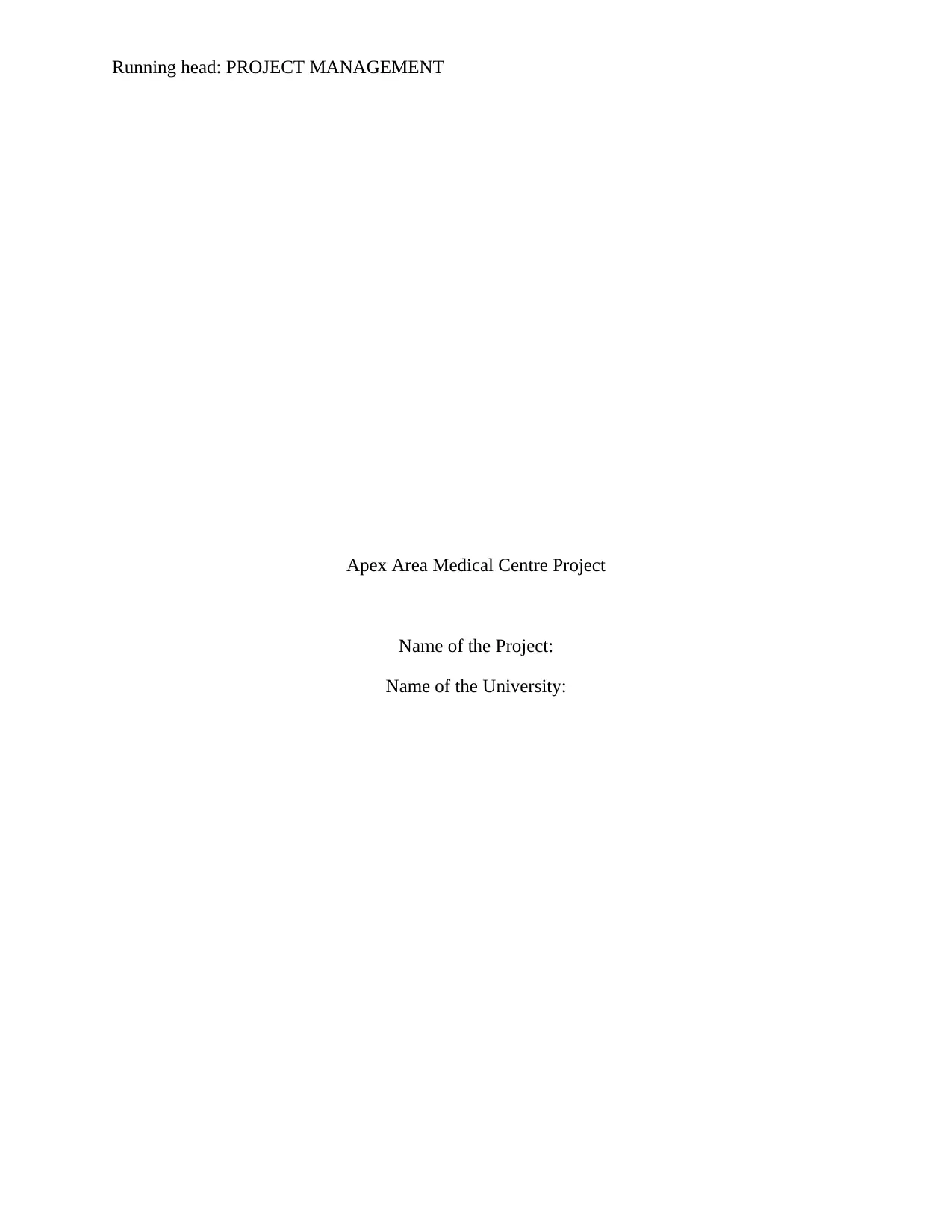
Running head: PROJECT MANAGEMENT
Apex Area Medical Centre Project
Name of the Project:
Name of the University:
Apex Area Medical Centre Project
Name of the Project:
Name of the University:
Paraphrase This Document
Need a fresh take? Get an instant paraphrase of this document with our AI Paraphraser
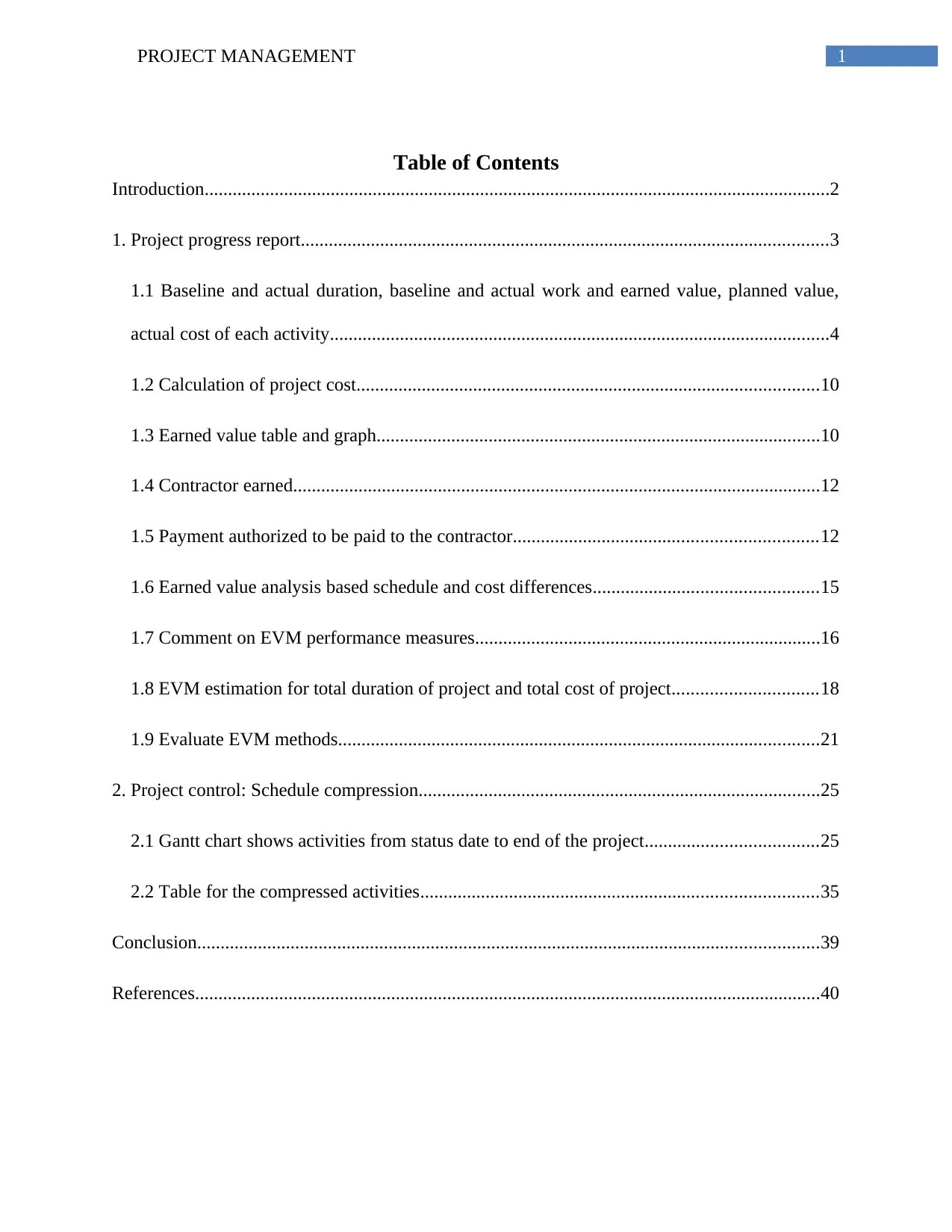
1PROJECT MANAGEMENT
Table of Contents
Introduction......................................................................................................................................2
1. Project progress report.................................................................................................................3
1.1 Baseline and actual duration, baseline and actual work and earned value, planned value,
actual cost of each activity...........................................................................................................4
1.2 Calculation of project cost...................................................................................................10
1.3 Earned value table and graph...............................................................................................10
1.4 Contractor earned.................................................................................................................12
1.5 Payment authorized to be paid to the contractor.................................................................12
1.6 Earned value analysis based schedule and cost differences................................................15
1.7 Comment on EVM performance measures..........................................................................16
1.8 EVM estimation for total duration of project and total cost of project...............................18
1.9 Evaluate EVM methods.......................................................................................................21
2. Project control: Schedule compression......................................................................................25
2.1 Gantt chart shows activities from status date to end of the project.....................................25
2.2 Table for the compressed activities.....................................................................................35
Conclusion.....................................................................................................................................39
References......................................................................................................................................40
Table of Contents
Introduction......................................................................................................................................2
1. Project progress report.................................................................................................................3
1.1 Baseline and actual duration, baseline and actual work and earned value, planned value,
actual cost of each activity...........................................................................................................4
1.2 Calculation of project cost...................................................................................................10
1.3 Earned value table and graph...............................................................................................10
1.4 Contractor earned.................................................................................................................12
1.5 Payment authorized to be paid to the contractor.................................................................12
1.6 Earned value analysis based schedule and cost differences................................................15
1.7 Comment on EVM performance measures..........................................................................16
1.8 EVM estimation for total duration of project and total cost of project...............................18
1.9 Evaluate EVM methods.......................................................................................................21
2. Project control: Schedule compression......................................................................................25
2.1 Gantt chart shows activities from status date to end of the project.....................................25
2.2 Table for the compressed activities.....................................................................................35
Conclusion.....................................................................................................................................39
References......................................................................................................................................40
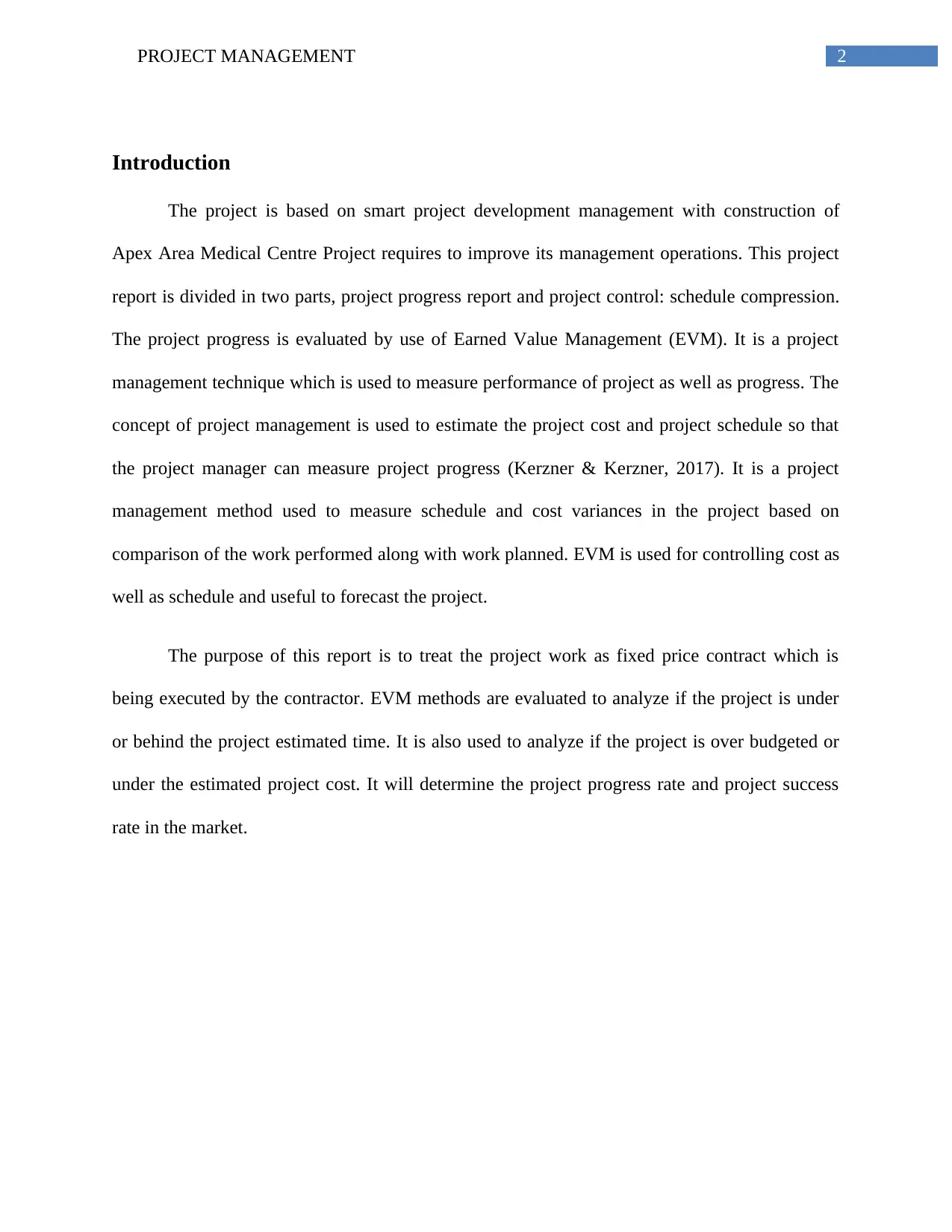
2PROJECT MANAGEMENT
Introduction
The project is based on smart project development management with construction of
Apex Area Medical Centre Project requires to improve its management operations. This project
report is divided in two parts, project progress report and project control: schedule compression.
The project progress is evaluated by use of Earned Value Management (EVM). It is a project
management technique which is used to measure performance of project as well as progress. The
concept of project management is used to estimate the project cost and project schedule so that
the project manager can measure project progress (Kerzner & Kerzner, 2017). It is a project
management method used to measure schedule and cost variances in the project based on
comparison of the work performed along with work planned. EVM is used for controlling cost as
well as schedule and useful to forecast the project.
The purpose of this report is to treat the project work as fixed price contract which is
being executed by the contractor. EVM methods are evaluated to analyze if the project is under
or behind the project estimated time. It is also used to analyze if the project is over budgeted or
under the estimated project cost. It will determine the project progress rate and project success
rate in the market.
Introduction
The project is based on smart project development management with construction of
Apex Area Medical Centre Project requires to improve its management operations. This project
report is divided in two parts, project progress report and project control: schedule compression.
The project progress is evaluated by use of Earned Value Management (EVM). It is a project
management technique which is used to measure performance of project as well as progress. The
concept of project management is used to estimate the project cost and project schedule so that
the project manager can measure project progress (Kerzner & Kerzner, 2017). It is a project
management method used to measure schedule and cost variances in the project based on
comparison of the work performed along with work planned. EVM is used for controlling cost as
well as schedule and useful to forecast the project.
The purpose of this report is to treat the project work as fixed price contract which is
being executed by the contractor. EVM methods are evaluated to analyze if the project is under
or behind the project estimated time. It is also used to analyze if the project is over budgeted or
under the estimated project cost. It will determine the project progress rate and project success
rate in the market.
⊘ This is a preview!⊘
Do you want full access?
Subscribe today to unlock all pages.

Trusted by 1+ million students worldwide
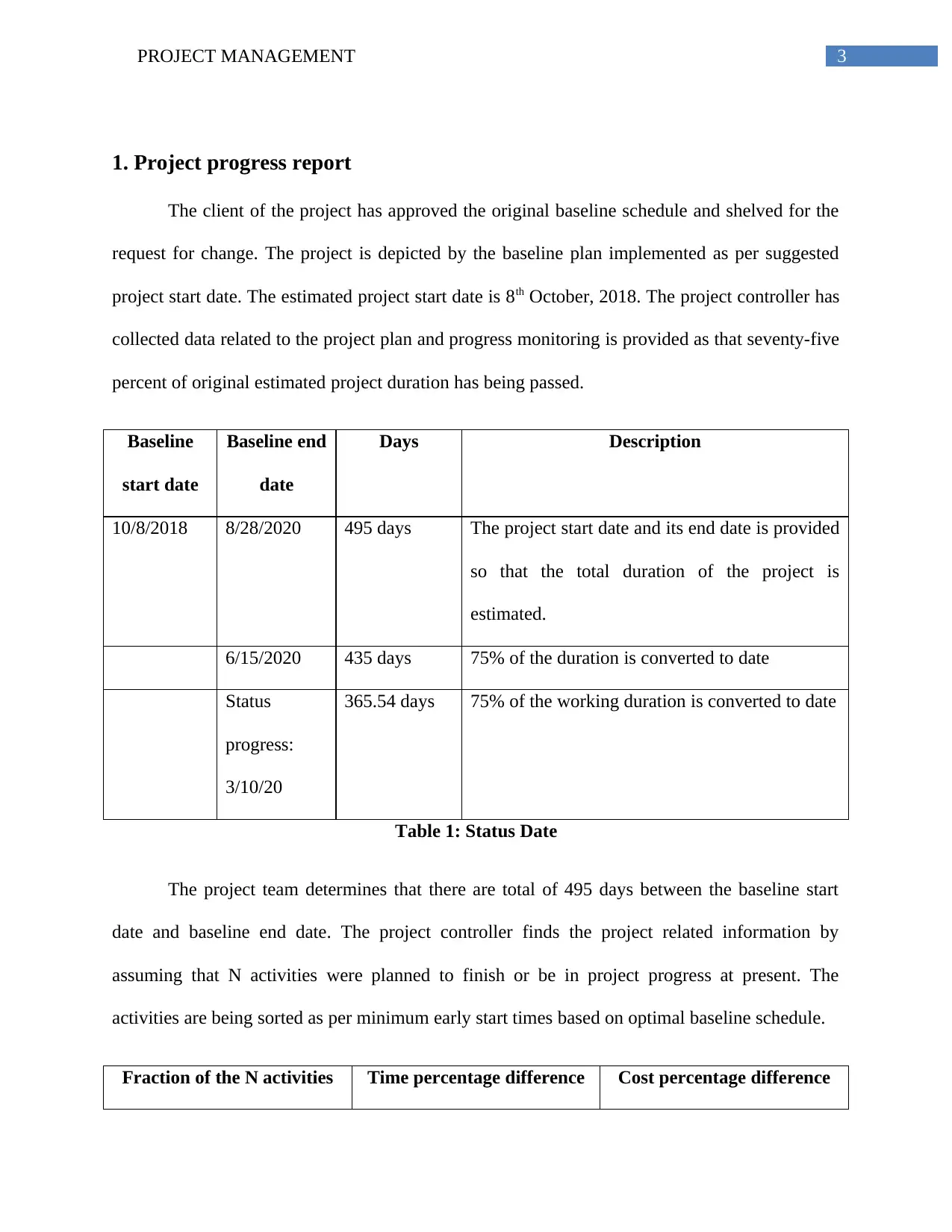
3PROJECT MANAGEMENT
1. Project progress report
The client of the project has approved the original baseline schedule and shelved for the
request for change. The project is depicted by the baseline plan implemented as per suggested
project start date. The estimated project start date is 8th October, 2018. The project controller has
collected data related to the project plan and progress monitoring is provided as that seventy-five
percent of original estimated project duration has being passed.
Baseline
start date
Baseline end
date
Days Description
10/8/2018 8/28/2020 495 days The project start date and its end date is provided
so that the total duration of the project is
estimated.
6/15/2020 435 days 75% of the duration is converted to date
Status
progress:
3/10/20
365.54 days 75% of the working duration is converted to date
Table 1: Status Date
The project team determines that there are total of 495 days between the baseline start
date and baseline end date. The project controller finds the project related information by
assuming that N activities were planned to finish or be in project progress at present. The
activities are being sorted as per minimum early start times based on optimal baseline schedule.
Fraction of the N activities Time percentage difference Cost percentage difference
1. Project progress report
The client of the project has approved the original baseline schedule and shelved for the
request for change. The project is depicted by the baseline plan implemented as per suggested
project start date. The estimated project start date is 8th October, 2018. The project controller has
collected data related to the project plan and progress monitoring is provided as that seventy-five
percent of original estimated project duration has being passed.
Baseline
start date
Baseline end
date
Days Description
10/8/2018 8/28/2020 495 days The project start date and its end date is provided
so that the total duration of the project is
estimated.
6/15/2020 435 days 75% of the duration is converted to date
Status
progress:
3/10/20
365.54 days 75% of the working duration is converted to date
Table 1: Status Date
The project team determines that there are total of 495 days between the baseline start
date and baseline end date. The project controller finds the project related information by
assuming that N activities were planned to finish or be in project progress at present. The
activities are being sorted as per minimum early start times based on optimal baseline schedule.
Fraction of the N activities Time percentage difference Cost percentage difference
Paraphrase This Document
Need a fresh take? Get an instant paraphrase of this document with our AI Paraphraser
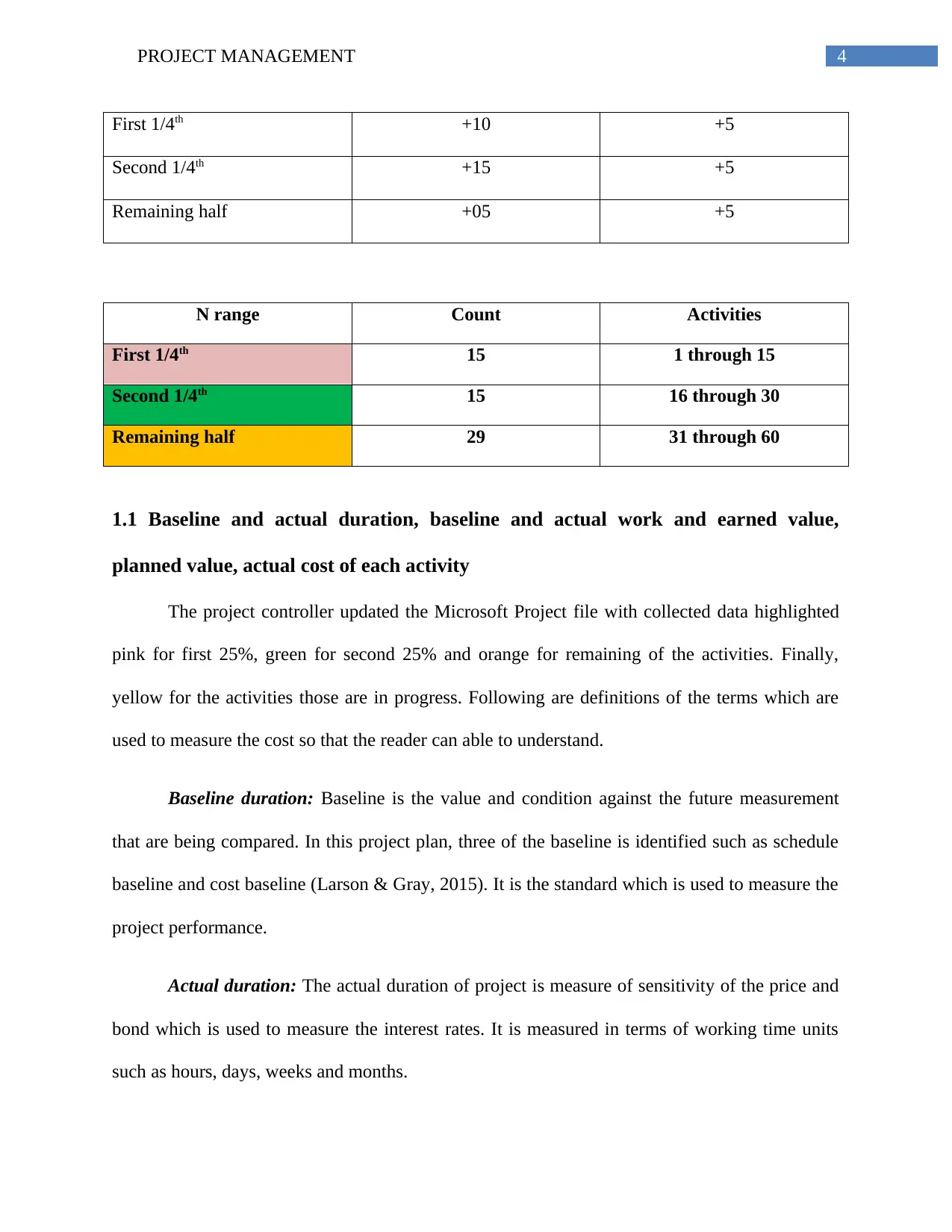
4PROJECT MANAGEMENT
First 1/4th +10 +5
Second 1/4th +15 +5
Remaining half +05 +5
N range Count Activities
First 1/4th 15 1 through 15
Second 1/4th 15 16 through 30
Remaining half 29 31 through 60
1.1 Baseline and actual duration, baseline and actual work and earned value,
planned value, actual cost of each activity
The project controller updated the Microsoft Project file with collected data highlighted
pink for first 25%, green for second 25% and orange for remaining of the activities. Finally,
yellow for the activities those are in progress. Following are definitions of the terms which are
used to measure the cost so that the reader can able to understand.
Baseline duration: Baseline is the value and condition against the future measurement
that are being compared. In this project plan, three of the baseline is identified such as schedule
baseline and cost baseline (Larson & Gray, 2015). It is the standard which is used to measure the
project performance.
Actual duration: The actual duration of project is measure of sensitivity of the price and
bond which is used to measure the interest rates. It is measured in terms of working time units
such as hours, days, weeks and months.
First 1/4th +10 +5
Second 1/4th +15 +5
Remaining half +05 +5
N range Count Activities
First 1/4th 15 1 through 15
Second 1/4th 15 16 through 30
Remaining half 29 31 through 60
1.1 Baseline and actual duration, baseline and actual work and earned value,
planned value, actual cost of each activity
The project controller updated the Microsoft Project file with collected data highlighted
pink for first 25%, green for second 25% and orange for remaining of the activities. Finally,
yellow for the activities those are in progress. Following are definitions of the terms which are
used to measure the cost so that the reader can able to understand.
Baseline duration: Baseline is the value and condition against the future measurement
that are being compared. In this project plan, three of the baseline is identified such as schedule
baseline and cost baseline (Larson & Gray, 2015). It is the standard which is used to measure the
project performance.
Actual duration: The actual duration of project is measure of sensitivity of the price and
bond which is used to measure the interest rates. It is measured in terms of working time units
such as hours, days, weeks and months.
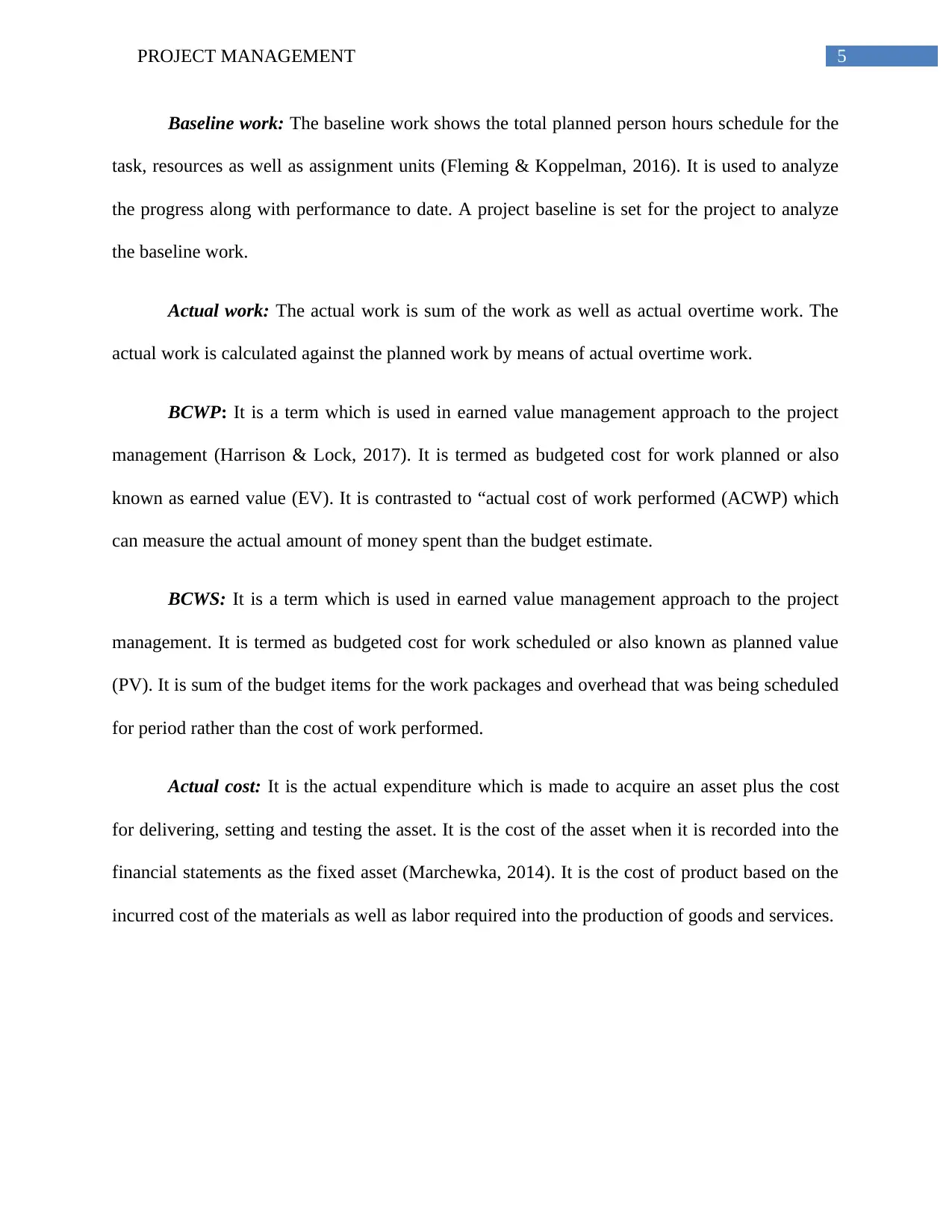
5PROJECT MANAGEMENT
Baseline work: The baseline work shows the total planned person hours schedule for the
task, resources as well as assignment units (Fleming & Koppelman, 2016). It is used to analyze
the progress along with performance to date. A project baseline is set for the project to analyze
the baseline work.
Actual work: The actual work is sum of the work as well as actual overtime work. The
actual work is calculated against the planned work by means of actual overtime work.
BCWP: It is a term which is used in earned value management approach to the project
management (Harrison & Lock, 2017). It is termed as budgeted cost for work planned or also
known as earned value (EV). It is contrasted to “actual cost of work performed (ACWP) which
can measure the actual amount of money spent than the budget estimate.
BCWS: It is a term which is used in earned value management approach to the project
management. It is termed as budgeted cost for work scheduled or also known as planned value
(PV). It is sum of the budget items for the work packages and overhead that was being scheduled
for period rather than the cost of work performed.
Actual cost: It is the actual expenditure which is made to acquire an asset plus the cost
for delivering, setting and testing the asset. It is the cost of the asset when it is recorded into the
financial statements as the fixed asset (Marchewka, 2014). It is the cost of product based on the
incurred cost of the materials as well as labor required into the production of goods and services.
Baseline work: The baseline work shows the total planned person hours schedule for the
task, resources as well as assignment units (Fleming & Koppelman, 2016). It is used to analyze
the progress along with performance to date. A project baseline is set for the project to analyze
the baseline work.
Actual work: The actual work is sum of the work as well as actual overtime work. The
actual work is calculated against the planned work by means of actual overtime work.
BCWP: It is a term which is used in earned value management approach to the project
management (Harrison & Lock, 2017). It is termed as budgeted cost for work planned or also
known as earned value (EV). It is contrasted to “actual cost of work performed (ACWP) which
can measure the actual amount of money spent than the budget estimate.
BCWS: It is a term which is used in earned value management approach to the project
management. It is termed as budgeted cost for work scheduled or also known as planned value
(PV). It is sum of the budget items for the work packages and overhead that was being scheduled
for period rather than the cost of work performed.
Actual cost: It is the actual expenditure which is made to acquire an asset plus the cost
for delivering, setting and testing the asset. It is the cost of the asset when it is recorded into the
financial statements as the fixed asset (Marchewka, 2014). It is the cost of product based on the
incurred cost of the materials as well as labor required into the production of goods and services.
⊘ This is a preview!⊘
Do you want full access?
Subscribe today to unlock all pages.

Trusted by 1+ million students worldwide
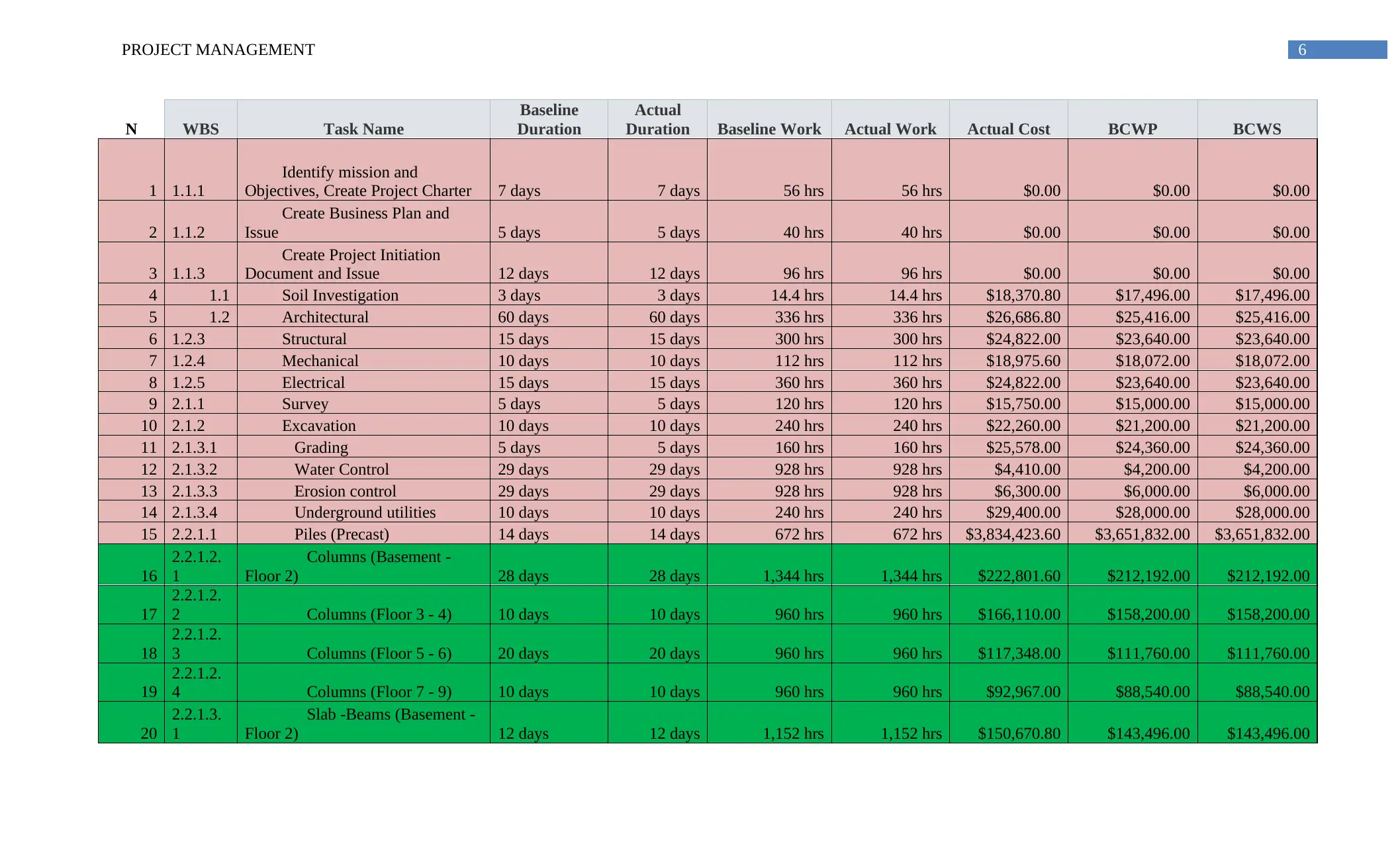
6PROJECT MANAGEMENT
N WBS Task Name
Baseline
Duration
Actual
Duration Baseline Work Actual Work Actual Cost BCWP BCWS
1 1.1.1
Identify mission and
Objectives, Create Project Charter 7 days 7 days 56 hrs 56 hrs $0.00 $0.00 $0.00
2 1.1.2
Create Business Plan and
Issue 5 days 5 days 40 hrs 40 hrs $0.00 $0.00 $0.00
3 1.1.3
Create Project Initiation
Document and Issue 12 days 12 days 96 hrs 96 hrs $0.00 $0.00 $0.00
4 1.1 Soil Investigation 3 days 3 days 14.4 hrs 14.4 hrs $18,370.80 $17,496.00 $17,496.00
5 1.2 Architectural 60 days 60 days 336 hrs 336 hrs $26,686.80 $25,416.00 $25,416.00
6 1.2.3 Structural 15 days 15 days 300 hrs 300 hrs $24,822.00 $23,640.00 $23,640.00
7 1.2.4 Mechanical 10 days 10 days 112 hrs 112 hrs $18,975.60 $18,072.00 $18,072.00
8 1.2.5 Electrical 15 days 15 days 360 hrs 360 hrs $24,822.00 $23,640.00 $23,640.00
9 2.1.1 Survey 5 days 5 days 120 hrs 120 hrs $15,750.00 $15,000.00 $15,000.00
10 2.1.2 Excavation 10 days 10 days 240 hrs 240 hrs $22,260.00 $21,200.00 $21,200.00
11 2.1.3.1 Grading 5 days 5 days 160 hrs 160 hrs $25,578.00 $24,360.00 $24,360.00
12 2.1.3.2 Water Control 29 days 29 days 928 hrs 928 hrs $4,410.00 $4,200.00 $4,200.00
13 2.1.3.3 Erosion control 29 days 29 days 928 hrs 928 hrs $6,300.00 $6,000.00 $6,000.00
14 2.1.3.4 Underground utilities 10 days 10 days 240 hrs 240 hrs $29,400.00 $28,000.00 $28,000.00
15 2.2.1.1 Piles (Precast) 14 days 14 days 672 hrs 672 hrs $3,834,423.60 $3,651,832.00 $3,651,832.00
16
2.2.1.2.
1
Columns (Basement -
Floor 2) 28 days 28 days 1,344 hrs 1,344 hrs $222,801.60 $212,192.00 $212,192.00
17
2.2.1.2.
2 Columns (Floor 3 - 4) 10 days 10 days 960 hrs 960 hrs $166,110.00 $158,200.00 $158,200.00
18
2.2.1.2.
3 Columns (Floor 5 - 6) 20 days 20 days 960 hrs 960 hrs $117,348.00 $111,760.00 $111,760.00
19
2.2.1.2.
4 Columns (Floor 7 - 9) 10 days 10 days 960 hrs 960 hrs $92,967.00 $88,540.00 $88,540.00
20
2.2.1.3.
1
Slab -Beams (Basement -
Floor 2) 12 days 12 days 1,152 hrs 1,152 hrs $150,670.80 $143,496.00 $143,496.00
N WBS Task Name
Baseline
Duration
Actual
Duration Baseline Work Actual Work Actual Cost BCWP BCWS
1 1.1.1
Identify mission and
Objectives, Create Project Charter 7 days 7 days 56 hrs 56 hrs $0.00 $0.00 $0.00
2 1.1.2
Create Business Plan and
Issue 5 days 5 days 40 hrs 40 hrs $0.00 $0.00 $0.00
3 1.1.3
Create Project Initiation
Document and Issue 12 days 12 days 96 hrs 96 hrs $0.00 $0.00 $0.00
4 1.1 Soil Investigation 3 days 3 days 14.4 hrs 14.4 hrs $18,370.80 $17,496.00 $17,496.00
5 1.2 Architectural 60 days 60 days 336 hrs 336 hrs $26,686.80 $25,416.00 $25,416.00
6 1.2.3 Structural 15 days 15 days 300 hrs 300 hrs $24,822.00 $23,640.00 $23,640.00
7 1.2.4 Mechanical 10 days 10 days 112 hrs 112 hrs $18,975.60 $18,072.00 $18,072.00
8 1.2.5 Electrical 15 days 15 days 360 hrs 360 hrs $24,822.00 $23,640.00 $23,640.00
9 2.1.1 Survey 5 days 5 days 120 hrs 120 hrs $15,750.00 $15,000.00 $15,000.00
10 2.1.2 Excavation 10 days 10 days 240 hrs 240 hrs $22,260.00 $21,200.00 $21,200.00
11 2.1.3.1 Grading 5 days 5 days 160 hrs 160 hrs $25,578.00 $24,360.00 $24,360.00
12 2.1.3.2 Water Control 29 days 29 days 928 hrs 928 hrs $4,410.00 $4,200.00 $4,200.00
13 2.1.3.3 Erosion control 29 days 29 days 928 hrs 928 hrs $6,300.00 $6,000.00 $6,000.00
14 2.1.3.4 Underground utilities 10 days 10 days 240 hrs 240 hrs $29,400.00 $28,000.00 $28,000.00
15 2.2.1.1 Piles (Precast) 14 days 14 days 672 hrs 672 hrs $3,834,423.60 $3,651,832.00 $3,651,832.00
16
2.2.1.2.
1
Columns (Basement -
Floor 2) 28 days 28 days 1,344 hrs 1,344 hrs $222,801.60 $212,192.00 $212,192.00
17
2.2.1.2.
2 Columns (Floor 3 - 4) 10 days 10 days 960 hrs 960 hrs $166,110.00 $158,200.00 $158,200.00
18
2.2.1.2.
3 Columns (Floor 5 - 6) 20 days 20 days 960 hrs 960 hrs $117,348.00 $111,760.00 $111,760.00
19
2.2.1.2.
4 Columns (Floor 7 - 9) 10 days 10 days 960 hrs 960 hrs $92,967.00 $88,540.00 $88,540.00
20
2.2.1.3.
1
Slab -Beams (Basement -
Floor 2) 12 days 12 days 1,152 hrs 1,152 hrs $150,670.80 $143,496.00 $143,496.00
Paraphrase This Document
Need a fresh take? Get an instant paraphrase of this document with our AI Paraphraser
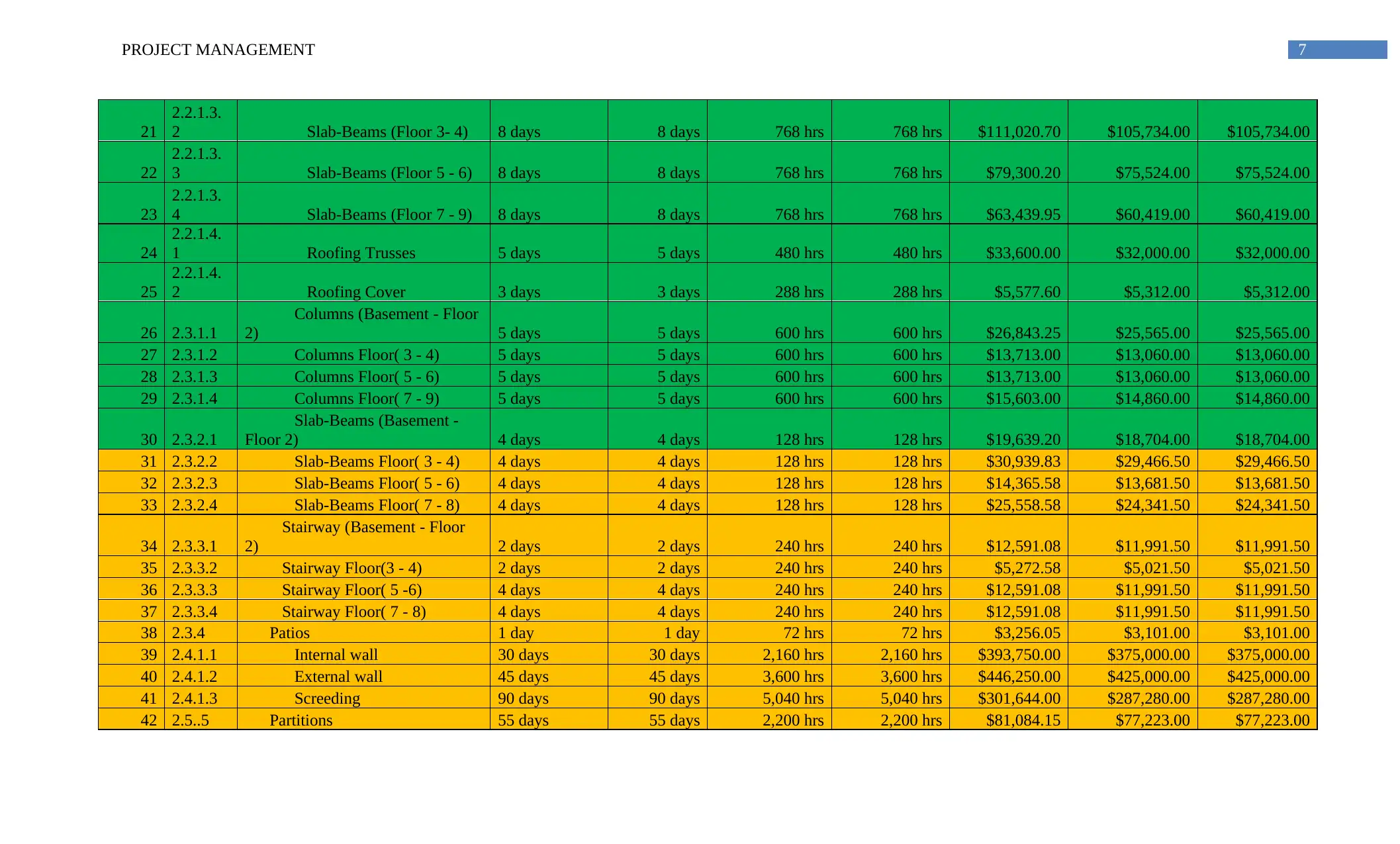
7PROJECT MANAGEMENT
21
2.2.1.3.
2 Slab-Beams (Floor 3- 4) 8 days 8 days 768 hrs 768 hrs $111,020.70 $105,734.00 $105,734.00
22
2.2.1.3.
3 Slab-Beams (Floor 5 - 6) 8 days 8 days 768 hrs 768 hrs $79,300.20 $75,524.00 $75,524.00
23
2.2.1.3.
4 Slab-Beams (Floor 7 - 9) 8 days 8 days 768 hrs 768 hrs $63,439.95 $60,419.00 $60,419.00
24
2.2.1.4.
1 Roofing Trusses 5 days 5 days 480 hrs 480 hrs $33,600.00 $32,000.00 $32,000.00
25
2.2.1.4.
2 Roofing Cover 3 days 3 days 288 hrs 288 hrs $5,577.60 $5,312.00 $5,312.00
26 2.3.1.1
Columns (Basement - Floor
2) 5 days 5 days 600 hrs 600 hrs $26,843.25 $25,565.00 $25,565.00
27 2.3.1.2 Columns Floor( 3 - 4) 5 days 5 days 600 hrs 600 hrs $13,713.00 $13,060.00 $13,060.00
28 2.3.1.3 Columns Floor( 5 - 6) 5 days 5 days 600 hrs 600 hrs $13,713.00 $13,060.00 $13,060.00
29 2.3.1.4 Columns Floor( 7 - 9) 5 days 5 days 600 hrs 600 hrs $15,603.00 $14,860.00 $14,860.00
30 2.3.2.1
Slab-Beams (Basement -
Floor 2) 4 days 4 days 128 hrs 128 hrs $19,639.20 $18,704.00 $18,704.00
31 2.3.2.2 Slab-Beams Floor( 3 - 4) 4 days 4 days 128 hrs 128 hrs $30,939.83 $29,466.50 $29,466.50
32 2.3.2.3 Slab-Beams Floor( 5 - 6) 4 days 4 days 128 hrs 128 hrs $14,365.58 $13,681.50 $13,681.50
33 2.3.2.4 Slab-Beams Floor( 7 - 8) 4 days 4 days 128 hrs 128 hrs $25,558.58 $24,341.50 $24,341.50
34 2.3.3.1
Stairway (Basement - Floor
2) 2 days 2 days 240 hrs 240 hrs $12,591.08 $11,991.50 $11,991.50
35 2.3.3.2 Stairway Floor(3 - 4) 2 days 2 days 240 hrs 240 hrs $5,272.58 $5,021.50 $5,021.50
36 2.3.3.3 Stairway Floor( 5 -6) 4 days 4 days 240 hrs 240 hrs $12,591.08 $11,991.50 $11,991.50
37 2.3.3.4 Stairway Floor( 7 - 8) 4 days 4 days 240 hrs 240 hrs $12,591.08 $11,991.50 $11,991.50
38 2.3.4 Patios 1 day 1 day 72 hrs 72 hrs $3,256.05 $3,101.00 $3,101.00
39 2.4.1.1 Internal wall 30 days 30 days 2,160 hrs 2,160 hrs $393,750.00 $375,000.00 $375,000.00
40 2.4.1.2 External wall 45 days 45 days 3,600 hrs 3,600 hrs $446,250.00 $425,000.00 $425,000.00
41 2.4.1.3 Screeding 90 days 90 days 5,040 hrs 5,040 hrs $301,644.00 $287,280.00 $287,280.00
42 2.5..5 Partitions 55 days 55 days 2,200 hrs 2,200 hrs $81,084.15 $77,223.00 $77,223.00
21
2.2.1.3.
2 Slab-Beams (Floor 3- 4) 8 days 8 days 768 hrs 768 hrs $111,020.70 $105,734.00 $105,734.00
22
2.2.1.3.
3 Slab-Beams (Floor 5 - 6) 8 days 8 days 768 hrs 768 hrs $79,300.20 $75,524.00 $75,524.00
23
2.2.1.3.
4 Slab-Beams (Floor 7 - 9) 8 days 8 days 768 hrs 768 hrs $63,439.95 $60,419.00 $60,419.00
24
2.2.1.4.
1 Roofing Trusses 5 days 5 days 480 hrs 480 hrs $33,600.00 $32,000.00 $32,000.00
25
2.2.1.4.
2 Roofing Cover 3 days 3 days 288 hrs 288 hrs $5,577.60 $5,312.00 $5,312.00
26 2.3.1.1
Columns (Basement - Floor
2) 5 days 5 days 600 hrs 600 hrs $26,843.25 $25,565.00 $25,565.00
27 2.3.1.2 Columns Floor( 3 - 4) 5 days 5 days 600 hrs 600 hrs $13,713.00 $13,060.00 $13,060.00
28 2.3.1.3 Columns Floor( 5 - 6) 5 days 5 days 600 hrs 600 hrs $13,713.00 $13,060.00 $13,060.00
29 2.3.1.4 Columns Floor( 7 - 9) 5 days 5 days 600 hrs 600 hrs $15,603.00 $14,860.00 $14,860.00
30 2.3.2.1
Slab-Beams (Basement -
Floor 2) 4 days 4 days 128 hrs 128 hrs $19,639.20 $18,704.00 $18,704.00
31 2.3.2.2 Slab-Beams Floor( 3 - 4) 4 days 4 days 128 hrs 128 hrs $30,939.83 $29,466.50 $29,466.50
32 2.3.2.3 Slab-Beams Floor( 5 - 6) 4 days 4 days 128 hrs 128 hrs $14,365.58 $13,681.50 $13,681.50
33 2.3.2.4 Slab-Beams Floor( 7 - 8) 4 days 4 days 128 hrs 128 hrs $25,558.58 $24,341.50 $24,341.50
34 2.3.3.1
Stairway (Basement - Floor
2) 2 days 2 days 240 hrs 240 hrs $12,591.08 $11,991.50 $11,991.50
35 2.3.3.2 Stairway Floor(3 - 4) 2 days 2 days 240 hrs 240 hrs $5,272.58 $5,021.50 $5,021.50
36 2.3.3.3 Stairway Floor( 5 -6) 4 days 4 days 240 hrs 240 hrs $12,591.08 $11,991.50 $11,991.50
37 2.3.3.4 Stairway Floor( 7 - 8) 4 days 4 days 240 hrs 240 hrs $12,591.08 $11,991.50 $11,991.50
38 2.3.4 Patios 1 day 1 day 72 hrs 72 hrs $3,256.05 $3,101.00 $3,101.00
39 2.4.1.1 Internal wall 30 days 30 days 2,160 hrs 2,160 hrs $393,750.00 $375,000.00 $375,000.00
40 2.4.1.2 External wall 45 days 45 days 3,600 hrs 3,600 hrs $446,250.00 $425,000.00 $425,000.00
41 2.4.1.3 Screeding 90 days 90 days 5,040 hrs 5,040 hrs $301,644.00 $287,280.00 $287,280.00
42 2.5..5 Partitions 55 days 55 days 2,200 hrs 2,200 hrs $81,084.15 $77,223.00 $77,223.00
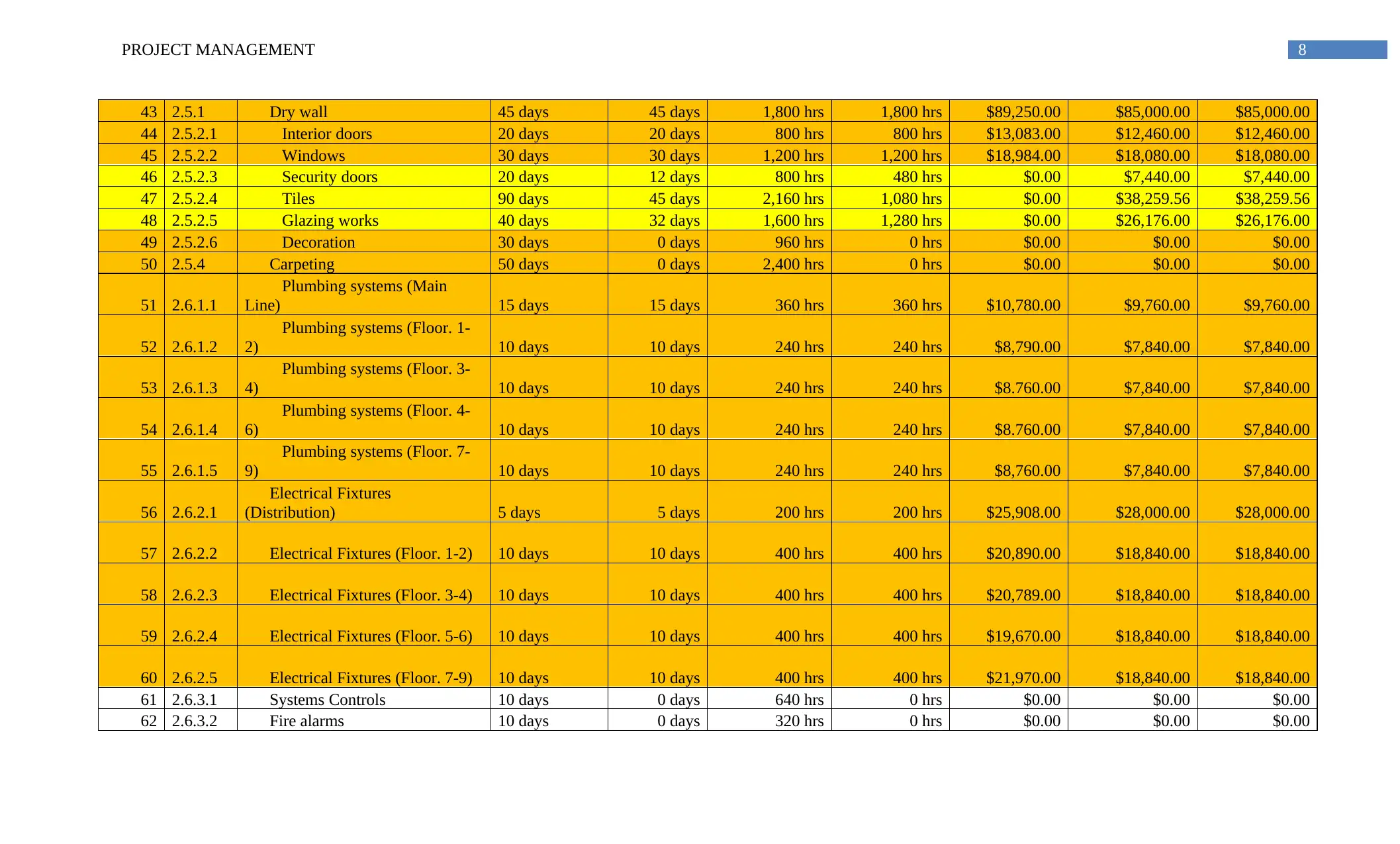
8PROJECT MANAGEMENT
43 2.5.1 Dry wall 45 days 45 days 1,800 hrs 1,800 hrs $89,250.00 $85,000.00 $85,000.00
44 2.5.2.1 Interior doors 20 days 20 days 800 hrs 800 hrs $13,083.00 $12,460.00 $12,460.00
45 2.5.2.2 Windows 30 days 30 days 1,200 hrs 1,200 hrs $18,984.00 $18,080.00 $18,080.00
46 2.5.2.3 Security doors 20 days 12 days 800 hrs 480 hrs $0.00 $7,440.00 $7,440.00
47 2.5.2.4 Tiles 90 days 45 days 2,160 hrs 1,080 hrs $0.00 $38,259.56 $38,259.56
48 2.5.2.5 Glazing works 40 days 32 days 1,600 hrs 1,280 hrs $0.00 $26,176.00 $26,176.00
49 2.5.2.6 Decoration 30 days 0 days 960 hrs 0 hrs $0.00 $0.00 $0.00
50 2.5.4 Carpeting 50 days 0 days 2,400 hrs 0 hrs $0.00 $0.00 $0.00
51 2.6.1.1
Plumbing systems (Main
Line) 15 days 15 days 360 hrs 360 hrs $10,780.00 $9,760.00 $9,760.00
52 2.6.1.2
Plumbing systems (Floor. 1-
2) 10 days 10 days 240 hrs 240 hrs $8,790.00 $7,840.00 $7,840.00
53 2.6.1.3
Plumbing systems (Floor. 3-
4) 10 days 10 days 240 hrs 240 hrs $8.760.00 $7,840.00 $7,840.00
54 2.6.1.4
Plumbing systems (Floor. 4-
6) 10 days 10 days 240 hrs 240 hrs $8.760.00 $7,840.00 $7,840.00
55 2.6.1.5
Plumbing systems (Floor. 7-
9) 10 days 10 days 240 hrs 240 hrs $8,760.00 $7,840.00 $7,840.00
56 2.6.2.1
Electrical Fixtures
(Distribution) 5 days 5 days 200 hrs 200 hrs $25,908.00 $28,000.00 $28,000.00
57 2.6.2.2 Electrical Fixtures (Floor. 1-2) 10 days 10 days 400 hrs 400 hrs $20,890.00 $18,840.00 $18,840.00
58 2.6.2.3 Electrical Fixtures (Floor. 3-4) 10 days 10 days 400 hrs 400 hrs $20,789.00 $18,840.00 $18,840.00
59 2.6.2.4 Electrical Fixtures (Floor. 5-6) 10 days 10 days 400 hrs 400 hrs $19,670.00 $18,840.00 $18,840.00
60 2.6.2.5 Electrical Fixtures (Floor. 7-9) 10 days 10 days 400 hrs 400 hrs $21,970.00 $18,840.00 $18,840.00
61 2.6.3.1 Systems Controls 10 days 0 days 640 hrs 0 hrs $0.00 $0.00 $0.00
62 2.6.3.2 Fire alarms 10 days 0 days 320 hrs 0 hrs $0.00 $0.00 $0.00
43 2.5.1 Dry wall 45 days 45 days 1,800 hrs 1,800 hrs $89,250.00 $85,000.00 $85,000.00
44 2.5.2.1 Interior doors 20 days 20 days 800 hrs 800 hrs $13,083.00 $12,460.00 $12,460.00
45 2.5.2.2 Windows 30 days 30 days 1,200 hrs 1,200 hrs $18,984.00 $18,080.00 $18,080.00
46 2.5.2.3 Security doors 20 days 12 days 800 hrs 480 hrs $0.00 $7,440.00 $7,440.00
47 2.5.2.4 Tiles 90 days 45 days 2,160 hrs 1,080 hrs $0.00 $38,259.56 $38,259.56
48 2.5.2.5 Glazing works 40 days 32 days 1,600 hrs 1,280 hrs $0.00 $26,176.00 $26,176.00
49 2.5.2.6 Decoration 30 days 0 days 960 hrs 0 hrs $0.00 $0.00 $0.00
50 2.5.4 Carpeting 50 days 0 days 2,400 hrs 0 hrs $0.00 $0.00 $0.00
51 2.6.1.1
Plumbing systems (Main
Line) 15 days 15 days 360 hrs 360 hrs $10,780.00 $9,760.00 $9,760.00
52 2.6.1.2
Plumbing systems (Floor. 1-
2) 10 days 10 days 240 hrs 240 hrs $8,790.00 $7,840.00 $7,840.00
53 2.6.1.3
Plumbing systems (Floor. 3-
4) 10 days 10 days 240 hrs 240 hrs $8.760.00 $7,840.00 $7,840.00
54 2.6.1.4
Plumbing systems (Floor. 4-
6) 10 days 10 days 240 hrs 240 hrs $8.760.00 $7,840.00 $7,840.00
55 2.6.1.5
Plumbing systems (Floor. 7-
9) 10 days 10 days 240 hrs 240 hrs $8,760.00 $7,840.00 $7,840.00
56 2.6.2.1
Electrical Fixtures
(Distribution) 5 days 5 days 200 hrs 200 hrs $25,908.00 $28,000.00 $28,000.00
57 2.6.2.2 Electrical Fixtures (Floor. 1-2) 10 days 10 days 400 hrs 400 hrs $20,890.00 $18,840.00 $18,840.00
58 2.6.2.3 Electrical Fixtures (Floor. 3-4) 10 days 10 days 400 hrs 400 hrs $20,789.00 $18,840.00 $18,840.00
59 2.6.2.4 Electrical Fixtures (Floor. 5-6) 10 days 10 days 400 hrs 400 hrs $19,670.00 $18,840.00 $18,840.00
60 2.6.2.5 Electrical Fixtures (Floor. 7-9) 10 days 10 days 400 hrs 400 hrs $21,970.00 $18,840.00 $18,840.00
61 2.6.3.1 Systems Controls 10 days 0 days 640 hrs 0 hrs $0.00 $0.00 $0.00
62 2.6.3.2 Fire alarms 10 days 0 days 320 hrs 0 hrs $0.00 $0.00 $0.00
⊘ This is a preview!⊘
Do you want full access?
Subscribe today to unlock all pages.

Trusted by 1+ million students worldwide
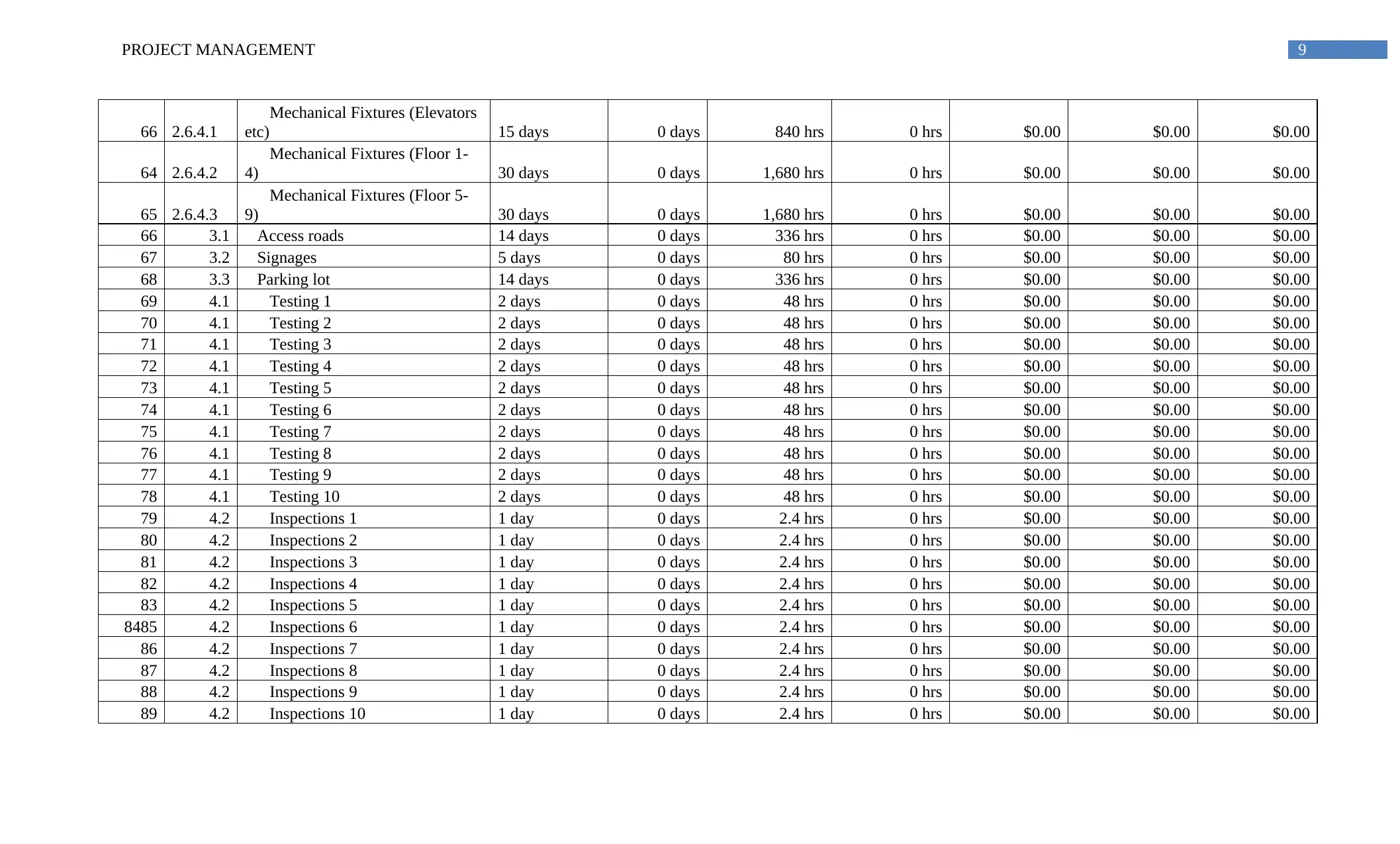
9PROJECT MANAGEMENT
66 2.6.4.1
Mechanical Fixtures (Elevators
etc) 15 days 0 days 840 hrs 0 hrs $0.00 $0.00 $0.00
64 2.6.4.2
Mechanical Fixtures (Floor 1-
4) 30 days 0 days 1,680 hrs 0 hrs $0.00 $0.00 $0.00
65 2.6.4.3
Mechanical Fixtures (Floor 5-
9) 30 days 0 days 1,680 hrs 0 hrs $0.00 $0.00 $0.00
66 3.1 Access roads 14 days 0 days 336 hrs 0 hrs $0.00 $0.00 $0.00
67 3.2 Signages 5 days 0 days 80 hrs 0 hrs $0.00 $0.00 $0.00
68 3.3 Parking lot 14 days 0 days 336 hrs 0 hrs $0.00 $0.00 $0.00
69 4.1 Testing 1 2 days 0 days 48 hrs 0 hrs $0.00 $0.00 $0.00
70 4.1 Testing 2 2 days 0 days 48 hrs 0 hrs $0.00 $0.00 $0.00
71 4.1 Testing 3 2 days 0 days 48 hrs 0 hrs $0.00 $0.00 $0.00
72 4.1 Testing 4 2 days 0 days 48 hrs 0 hrs $0.00 $0.00 $0.00
73 4.1 Testing 5 2 days 0 days 48 hrs 0 hrs $0.00 $0.00 $0.00
74 4.1 Testing 6 2 days 0 days 48 hrs 0 hrs $0.00 $0.00 $0.00
75 4.1 Testing 7 2 days 0 days 48 hrs 0 hrs $0.00 $0.00 $0.00
76 4.1 Testing 8 2 days 0 days 48 hrs 0 hrs $0.00 $0.00 $0.00
77 4.1 Testing 9 2 days 0 days 48 hrs 0 hrs $0.00 $0.00 $0.00
78 4.1 Testing 10 2 days 0 days 48 hrs 0 hrs $0.00 $0.00 $0.00
79 4.2 Inspections 1 1 day 0 days 2.4 hrs 0 hrs $0.00 $0.00 $0.00
80 4.2 Inspections 2 1 day 0 days 2.4 hrs 0 hrs $0.00 $0.00 $0.00
81 4.2 Inspections 3 1 day 0 days 2.4 hrs 0 hrs $0.00 $0.00 $0.00
82 4.2 Inspections 4 1 day 0 days 2.4 hrs 0 hrs $0.00 $0.00 $0.00
83 4.2 Inspections 5 1 day 0 days 2.4 hrs 0 hrs $0.00 $0.00 $0.00
8485 4.2 Inspections 6 1 day 0 days 2.4 hrs 0 hrs $0.00 $0.00 $0.00
86 4.2 Inspections 7 1 day 0 days 2.4 hrs 0 hrs $0.00 $0.00 $0.00
87 4.2 Inspections 8 1 day 0 days 2.4 hrs 0 hrs $0.00 $0.00 $0.00
88 4.2 Inspections 9 1 day 0 days 2.4 hrs 0 hrs $0.00 $0.00 $0.00
89 4.2 Inspections 10 1 day 0 days 2.4 hrs 0 hrs $0.00 $0.00 $0.00
66 2.6.4.1
Mechanical Fixtures (Elevators
etc) 15 days 0 days 840 hrs 0 hrs $0.00 $0.00 $0.00
64 2.6.4.2
Mechanical Fixtures (Floor 1-
4) 30 days 0 days 1,680 hrs 0 hrs $0.00 $0.00 $0.00
65 2.6.4.3
Mechanical Fixtures (Floor 5-
9) 30 days 0 days 1,680 hrs 0 hrs $0.00 $0.00 $0.00
66 3.1 Access roads 14 days 0 days 336 hrs 0 hrs $0.00 $0.00 $0.00
67 3.2 Signages 5 days 0 days 80 hrs 0 hrs $0.00 $0.00 $0.00
68 3.3 Parking lot 14 days 0 days 336 hrs 0 hrs $0.00 $0.00 $0.00
69 4.1 Testing 1 2 days 0 days 48 hrs 0 hrs $0.00 $0.00 $0.00
70 4.1 Testing 2 2 days 0 days 48 hrs 0 hrs $0.00 $0.00 $0.00
71 4.1 Testing 3 2 days 0 days 48 hrs 0 hrs $0.00 $0.00 $0.00
72 4.1 Testing 4 2 days 0 days 48 hrs 0 hrs $0.00 $0.00 $0.00
73 4.1 Testing 5 2 days 0 days 48 hrs 0 hrs $0.00 $0.00 $0.00
74 4.1 Testing 6 2 days 0 days 48 hrs 0 hrs $0.00 $0.00 $0.00
75 4.1 Testing 7 2 days 0 days 48 hrs 0 hrs $0.00 $0.00 $0.00
76 4.1 Testing 8 2 days 0 days 48 hrs 0 hrs $0.00 $0.00 $0.00
77 4.1 Testing 9 2 days 0 days 48 hrs 0 hrs $0.00 $0.00 $0.00
78 4.1 Testing 10 2 days 0 days 48 hrs 0 hrs $0.00 $0.00 $0.00
79 4.2 Inspections 1 1 day 0 days 2.4 hrs 0 hrs $0.00 $0.00 $0.00
80 4.2 Inspections 2 1 day 0 days 2.4 hrs 0 hrs $0.00 $0.00 $0.00
81 4.2 Inspections 3 1 day 0 days 2.4 hrs 0 hrs $0.00 $0.00 $0.00
82 4.2 Inspections 4 1 day 0 days 2.4 hrs 0 hrs $0.00 $0.00 $0.00
83 4.2 Inspections 5 1 day 0 days 2.4 hrs 0 hrs $0.00 $0.00 $0.00
8485 4.2 Inspections 6 1 day 0 days 2.4 hrs 0 hrs $0.00 $0.00 $0.00
86 4.2 Inspections 7 1 day 0 days 2.4 hrs 0 hrs $0.00 $0.00 $0.00
87 4.2 Inspections 8 1 day 0 days 2.4 hrs 0 hrs $0.00 $0.00 $0.00
88 4.2 Inspections 9 1 day 0 days 2.4 hrs 0 hrs $0.00 $0.00 $0.00
89 4.2 Inspections 10 1 day 0 days 2.4 hrs 0 hrs $0.00 $0.00 $0.00
Paraphrase This Document
Need a fresh take? Get an instant paraphrase of this document with our AI Paraphraser
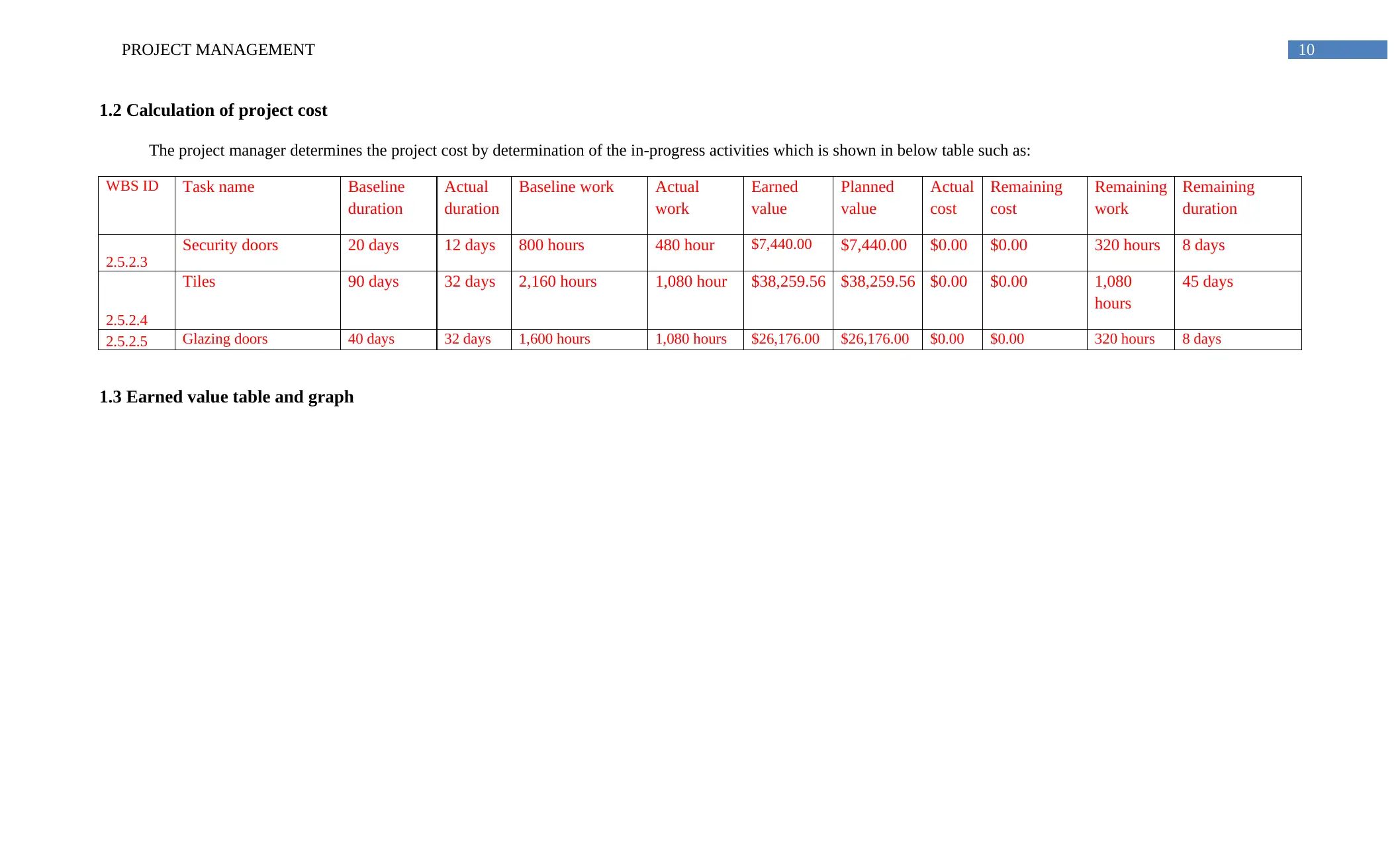
10PROJECT MANAGEMENT
1.2 Calculation of project cost
The project manager determines the project cost by determination of the in-progress activities which is shown in below table such as:
WBS ID Task name Baseline
duration
Actual
duration
Baseline work Actual
work
Earned
value
Planned
value
Actual
cost
Remaining
cost
Remaining
work
Remaining
duration
2.5.2.3
Security doors 20 days 12 days 800 hours 480 hour $7,440.00 $7,440.00 $0.00 $0.00 320 hours 8 days
2.5.2.4
Tiles 90 days 32 days 2,160 hours 1,080 hour $38,259.56 $38,259.56 $0.00 $0.00 1,080
hours
45 days
2.5.2.5 Glazing doors 40 days 32 days 1,600 hours 1,080 hours $26,176.00 $26,176.00 $0.00 $0.00 320 hours 8 days
1.3 Earned value table and graph
1.2 Calculation of project cost
The project manager determines the project cost by determination of the in-progress activities which is shown in below table such as:
WBS ID Task name Baseline
duration
Actual
duration
Baseline work Actual
work
Earned
value
Planned
value
Actual
cost
Remaining
cost
Remaining
work
Remaining
duration
2.5.2.3
Security doors 20 days 12 days 800 hours 480 hour $7,440.00 $7,440.00 $0.00 $0.00 320 hours 8 days
2.5.2.4
Tiles 90 days 32 days 2,160 hours 1,080 hour $38,259.56 $38,259.56 $0.00 $0.00 1,080
hours
45 days
2.5.2.5 Glazing doors 40 days 32 days 1,600 hours 1,080 hours $26,176.00 $26,176.00 $0.00 $0.00 320 hours 8 days
1.3 Earned value table and graph
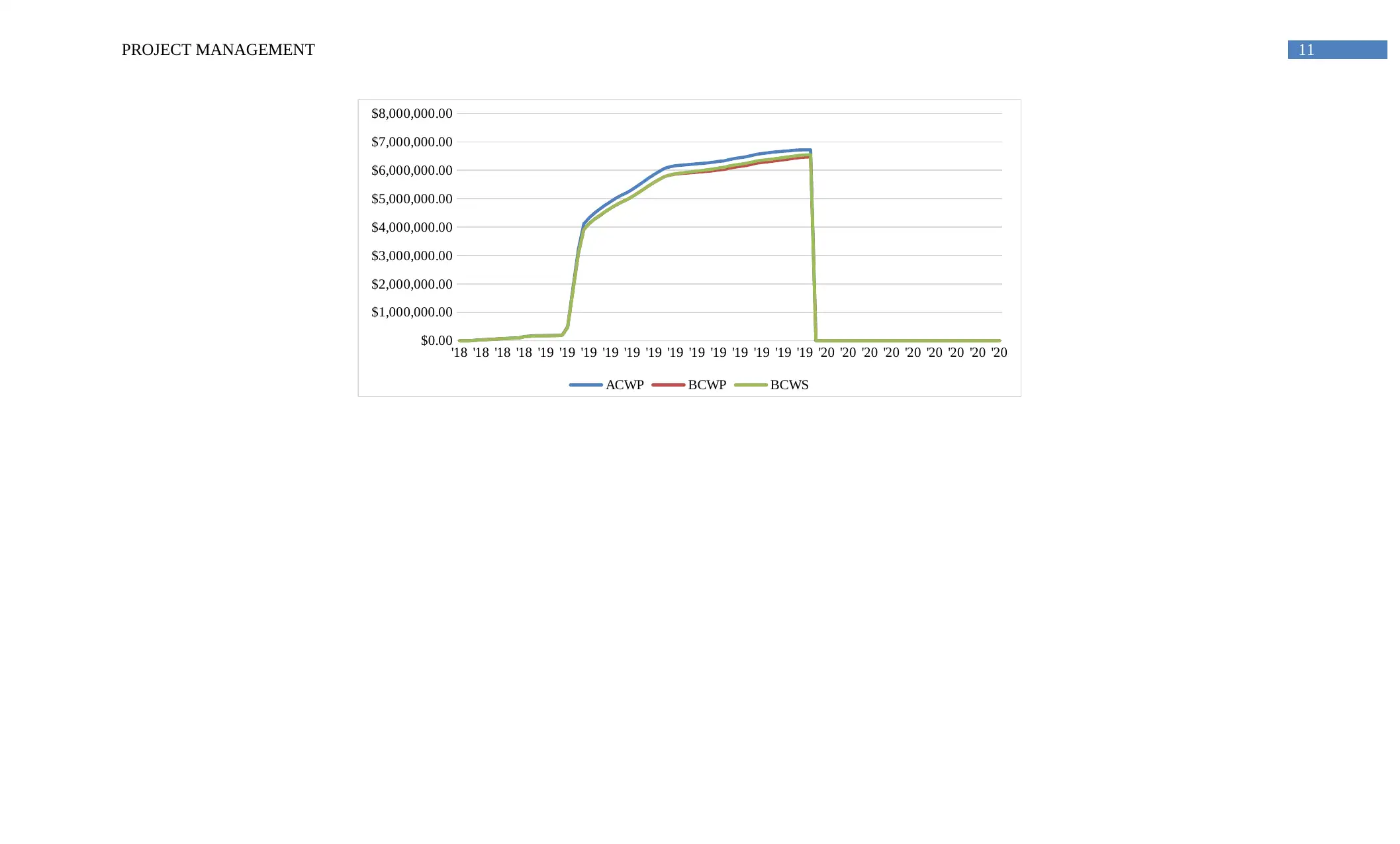
11PROJECT MANAGEMENT
'18 '18 '18 '18 '19 '19 '19 '19 '19 '19 '19 '19 '19 '19 '19 '19 '19 '20 '20 '20 '20 '20 '20 '20 '20 '20
$0.00
$1,000,000.00
$2,000,000.00
$3,000,000.00
$4,000,000.00
$5,000,000.00
$6,000,000.00
$7,000,000.00
$8,000,000.00
ACWP BCWP BCWS
'18 '18 '18 '18 '19 '19 '19 '19 '19 '19 '19 '19 '19 '19 '19 '19 '19 '20 '20 '20 '20 '20 '20 '20 '20 '20
$0.00
$1,000,000.00
$2,000,000.00
$3,000,000.00
$4,000,000.00
$5,000,000.00
$6,000,000.00
$7,000,000.00
$8,000,000.00
ACWP BCWP BCWS
⊘ This is a preview!⊘
Do you want full access?
Subscribe today to unlock all pages.

Trusted by 1+ million students worldwide
1 out of 42
Related Documents
Your All-in-One AI-Powered Toolkit for Academic Success.
+13062052269
info@desklib.com
Available 24*7 on WhatsApp / Email
![[object Object]](/_next/static/media/star-bottom.7253800d.svg)
Unlock your academic potential
Copyright © 2020–2025 A2Z Services. All Rights Reserved. Developed and managed by ZUCOL.




